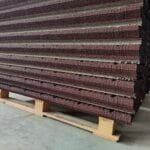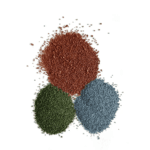As the uppermost covering structure of a building, the roof has the important task of protecting the building and its inhabitants from the outside environment. Among them, fire resistance is one of the important characteristics that roofing materials need to provide.
Factors affecting fire rating of roof tiles
Before comparing the fire ratings of various roofing materials, we need to know some of the factors that affect their fire ratings
Grading standards
Different countries and regions have set specific grading standards for the fire resistance of building materials. Common fire ratings include Class A, Class B, Class C and Class D, with Class A being the highest fire rating and Class D being the lowest. When selecting roofing materials, it is recommended that local building codes and standards be consulted to ensure that the materials selected meet or exceed the required fire rating.
Usage of flame retardants
Many roofing materials can be made more fire resistant by adding flame retardants. Fire retardants are chemical substances that have the property of slowing the spread of fire. They are able to inhibit the combustion process and reduce the rate at which the fire spreads, thus slowing down the progression of the fire. There are many fire retardant treated roofing materials available in the market.
Fire resistance
In addition to fire protection, fire resistance is also an important consideration. Fire resistance refers to a material’s stability and resistance to heat in high temperature environments. Some materials are able to maintain structural integrity at high temperatures and resist fire for extended periods of time. This is critical to slowing the spread of fire, providing escape time, and minimizing property damage.
Fire smoke evacuation and fire separation
In addition to the fire resistance of the roofing material itself, the design of fire smoke evacuation and fire separation should be considered. Fire smoke exhaust systems can effectively remove smoke and provide evacuation routes to ensure the safe evacuation of people. Fire isolation measures, such as fire walls and fire doors, can confine the fire to a specific area and reduce the spread of the fire.
Regular maintenance and inspections
Even if you choose a roofing material with good fire protection properties, regular maintenance and inspections are vital. Ensuring the integrity of the roofing material and repairing any damaged or deteriorated sections can effectively improve its fire performance and extend its service life.
Comparison of fire performance of four common roof tiles
Ceramic Tile Roofing
Tile roofs are a common roofing material such as ceramic tiles and concrete tiles. These tiles usually have good fire resistance properties and act as a barrier to protect the building from the threat of fire. Ceramic and concrete tiles are non-combustible or flame-retardant materials that can effectively resist the spread of fire. They resist high temperatures and do not burn easily when confronted with open flames, so they are usually categorized as Class A or B materials in terms of fire rating. In addition, shingle roofs are highly fire resistant and can withstand certain external forces and high temperatures, providing additional safety.
Metal Roofs
Metal roofs, such as steel and aluminum shingles, also perform better in terms of fire resistance. The metal itself is a non-combustible material and will not burn, thus effectively stopping the spread of fire. The fire performance of metal roofs is mainly affected by the thickness of their materials and coatings. Generally, the greater the thickness of a metal roof, the better its fire resistance. In addition, some metal roofs are coated to increase their fire resistance. These coatings usually utilize flame retardants that inhibit the spread of fire and increase the fire rating of the metal roof. However, it should be noted that metal roofs may expand and deform under prolonged high-temperature environments, so their thermal expansion properties need to be taken into account during design and construction.
Asphalt Shingle Roofs
Asphalt shingle roofs are more average in terms of fire performance. The asphalt shingle itself is a flammable material that burns easily when subjected to open flames or high-temperature heat sources. As a result, asphalt shingles are generally categorized as a Class C or D material when it comes to fire resistance. However, there are measures that can be taken to improve the fire resistance of asphalt shingle roofs. For example, adding flame retardants to the production process of asphalt shingles can slow down the spread of fire and improve its fire rating. In addition, timely maintenance and repair of asphalt shingle roofs to ensure their integrity and fire resistance are also important measures to improve the fire performance of asphalt shingle roofs.
Polymer Roofing Shingles
The fire performance of polymer roof tiles, such as polymerized vinyl chloride (PVC) tiles and polymer composite tiles, varies depending on the specific material and manufacturing process. Some high-quality polymer roof tiles employ the addition of flame retardants that can improve their fire retardant properties and achieve a higher fire rating. These flame retardants can effectively inhibit the spread of fire and reduce the risk of fire. However, it is important to note that some low-quality or poor-quality polymer roof tiles may have lower fire resistance, so it is important to pay attention to the quality certification and fire rating of the material when making your selection.
Conclusion
When selecting roofing materials, in addition to focusing on fire performance, a combination of fire rating requirements and building safety should be considered. Different regions and building types may have specific fire rating requirements for roofing materials that need to follow relevant building codes and standards. In addition, the quality of installation and construction of roofing materials can also affect their fire performance. Proper construction practices, correct fire separation measures, and regular maintenance are all important factors in ensuring the fire performance of roofing materials.
The fire performance of roofing materials is an important indicator of the safety of the building and its inhabitants. Tile and metal roofs usually have good fire resistance and can effectively resist the spread of fire. Asphalt shingle roofs have more average fire performance, but their fire ratings can be improved with the addition of fire retardants and regular maintenance. The fire performance of polymer roofing shingles varies depending on the material and manufacturing process, and selection requires attention to material quality and fire rating certification. When it comes to selecting roofing materials, comprehensive consideration should be given to fire rating requirements, building safety, and construction quality to ensure that the fire performance of the roof meets the expected standards and provides a reliable guarantee for the safety of homes. Contact with Skywalker China, we provide professional roofing information and supply quality roofing material of all kind.




